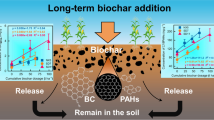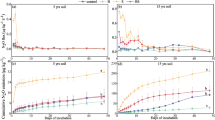Abstract
Olive oil agrifood industry generates large amounts of waste whose recycling as organic amendment represents an alternative to their disposal. The impact of de-oiled two-phase olive mill waste (DW) on the fate of 4-chloro-2-methylphenoxyacetic acid (MCPA) in Mediterranean agricultural soils was evaluated. Furthermore, the effect of the transformation of organic matter from this waste under field conditions was assessed. Four Mediterranean agricultural soils were selected and amended in laboratory with fresh DW and field-aged DW (DW and ADW treatments, respectively). Adsorption capacity increased by factors between 1.18 and 3.59, for the DW-amended soils, and by factor of 4.93, for ADW-amended soil, with respect to unamended soils, when 5 % amendment was applied. The DW amendment had inhibitory effect on dehydrogenase activity and slowed herbicide dissipation, whereas the opposite effect was observed in ADW treatments. In the field-amended soil, the amount of MCPA leached was significantly reduced from 56.9 % for unamended soil to 15.9 % at the 5 % rate. However, leaching losses of MCPA increased in the laboratory-amended soils, because of their high water-soluble organic carbon values which could enhance MCPA mobility, especially in the acidic soils. Therefore, the application of DW as organic amendment in Mediterranean agricultural soils could be an important management strategy to reduce MCPA leaching, especially if the organic matter had been previously transformed by ageing processes.



Similar content being viewed by others
References
Albarrán A, Celis R, Hermosín MC, López-Piñeiro A, Ortega-Calvo JJ, Cornejo J (2003) Effects of solid olive-mill waste addition to soil on sorption, degradation and leaching of the herbicide simazine. Soil Use Manag 19:150–156. doi:10.1111/j.1475-2743.2003.tb00296.x
Altieri R, Esposito A, Baruzzi G, Nair T (2014) Corroboration for the successful application of humified olive mill waste compost in soilless cultivation of strawberry. Int Biodeter Biodegr 88:118–124. doi:10.1016/j.ibiod.2013.12.006
Barbera AC, Maucieri C, Cavallaro V, Ioppolo A, Spagna G (2013) Effects of spreading olive mill waste water on soil properties and crops, a review. Agr Water Manag 119:43–53. doi:10.1016/j.agwat.2012.12.009
Barriuso E, Andrades MS, Benoit P, Houot S (2011) Pesticide desorption from soils facilitated by dissolved organic matter coming from composts: experimental data and modelling approach. Biogeochemistry 106:117–133. doi:10.1007/s10533-010-9481-y
Beulke S, Malkomes HP (2001) Effects of the herbicides metazachlor and dinoterb on the soil microflora and the degradation and sorption of metazachlor under different environmental conditions. Biol Fert Soils 33:467–471. doi:10.1007/s003740100354
Box JD (1983) Investigation of the Foline Ciocalteu phenol reagent for the determination of polyphenolic substances in natural waters. Water Res 17:511–525. doi:10.1016/0043-1354(83)90111-2
Cabrera A, Trigo C, Cox L, Celis R, Cornejo J (2008) A comparative study of the use of organoclay-based formulations and organic amendment to reduce the leaching of the herbicide MCPA in soil. Clean-Soil Air Water 36:990–995. doi:10.1002/clen.200800159
Cabrera D, López-Piñeiro A, Albarrán A, Peña D (2010) Direct and residual effects on diuron behaviour and persistence following two-phase olive mill waste addition to soil: field and laboratory experiments. Geoderma 157(3–4):133–141. doi:10.1016/j.geoderma.2010.04.004
Cabrera A, Cox L, Spokas KA, Celis R, Hermosín MC, Cornejo J, Koskinen WC (2011) Comparative sorption and leaching study of the herbicides fluometuron and 4-chloro-2-methylphenoxyacetic acid (MCPA) in a soil amended with biochars and other sorbents. J Agr Food Chem 59:12550–12560. doi:10.1021/jf202713q
Cañero AI, Becerra D, Cornejo J, Hermosín MC, Albarrán A, López-Piñeiro A, Cox L (2012) Transformation of organic wastes in soil: effect on bentazone behaviour. Sci Total Environ 433:198–205. doi:10.1016/j.scitotenv.2012.06.066
Celis R, Hermosín MC, Cox L, Cornejo J (1999) Sorption of 2,4-dichlorophenoxyacetic acid by model particles simulating naturally occurring soil colloids. Environ Sci Technol 33:1200–1206. doi:10.1021/es980659t
Cox L, Cecchi A, Celis R, Hermosín MC, Koskinen WC, Cornejo J (2001) Effect of exogenous carbon on movement of simazine and 2,4-D in soils. Soil Sci Soc Am J 65:1688–1695. doi:10.2136/sssaj2001.1688
Delgado-Moreno L, Peña A (2008) Sorption/desorption behaviour of sulfonylurea herbicides as affected by the addition of fresh and composted olive cake to soil. Weed Res 48:461–469. doi:10.1111/j.1365-3180.2008.00645.x
Delgado-Moreno L, Almendros G, Peña A (2007) Raw or incubated olive mill wastes and its biotransformed products as agricultural soil amendments—effect on sorption-desorption of triazine herbicides. J Agr Food Chem 55:836–843. doi:10.1021/jf060813s
Environment Agency (2003) Pesticides 2002: the Annual Report of the Environment Agency Pesticide Monitoring Programme. Wallingford
García C, Hernandez T, Costa C, Ceccanti B, Masciandaro G, Ciardi C (1993) A study of biochemical parameters of composted and fresh municipal wastes. Bioresour Technol 44:17–23. doi:10.1016/0960-8524(93)90202-M
Gianelli VR, Bedmar F, Costa JL (2014) Persistence and sorption of imazapyr on three Argentinean soils. Environ Toxicol Chem 33(1):29–34. doi:10.1002/etc.2400
Giles CH, MacEwan TH, Nakhwa SN, Smith D (1960) Studies in adsorption. Part XI. A system of classification of solution adsorption isotherms, and its use in diagnosis of adsorption mechanisms and in measurement of specific surface areas of solids. J Chem Soc 3:3973–3993. doi:10.1039/JR9600003973
Haberhauer G, Pfeiffer L, Gerzabek MH, Kirchmann H, Aquino AJA, Tunega D, Lischka H (2001) Response of sorption processes of MCPA to the amount and origin of organic matter in a long-term field experiment. Eur J Soil Sci 52:279–286. doi:10.1046/j.1365-2389.2001.00382.x
Hiller E, Krascsenits Z, Čerňanský S (2008) Sorption of acetochlor, atrazine, 2,4-D, chlorotoluron, MCPA, and trifluralin in six soils from Slovakia. B Environ Contam Tox 80:412–416. doi:10.1007/s00128-008-9430-9
Hiller E, Bartal M, Milička J, Čerňanský S (2009) Environmental fate of the herbicide MCPA in two soils as affected by the presence of wheat ash. Water Air Soil Poll 197:395–402. doi:10.1007/s11270-008-9820-y
Hiller E, Čerňanský S, Zemanová L (2010) Sorption, degradation and leaching of the phenoxyacid herbicide MCPA in two agricultural soils. Pol J Environ Stud 19(2):315–321
Jacobsen CS, Van der Keur P, Iversen BV, Rosenberg P, Barlebo H, Torp S, Vosgerau H, Juhler RK, Ernstsen V, Rasmussen J, Brinch UC, Jacobsen OH (2008) Variation of MCPA, metribuzine, methyltriazine-amine and glyphosate degradation, sorption, mineralization and leaching in different soil horizons. Environ Pollut 156:794–802. doi:10.1016/j.envpol.2008.06.002
Jensen PH, Hansen HCB, Rasmussen J, Jacobsen OS (2004) Sorption-controlled degradation kinetics of MCPA in soil. Environ Sci Technol 38:6662–6668. doi:10.1021/es0494095
Kah M, Beulke S, Brown C (2007) Factors influencing degradation of pesticides in soil. J Agr Food Chem 55(11):4487–4492. doi:10.1021/jf0635356
López-Piñeiro A, Albarrán A, Cabrera D, Peña D, Becerra D (2012) Environmental fate of terbuthylazine in soils amended with fresh and aged final residue of the olive-oil extraction process. Int J Environ Res 6:933–944
López-Piñeiro A, Peña D, Albarrán A, Sánchez-Llerena J, Becerra D (2013) Behaviour of MCPA in four intensive cropping soils amended with fresh, composted, and aged olive mill waste. J Contam Hydrol 152:137–146. doi:10.1016/j.jconhyd.2013.07.003
López-Piñeiro A, Peña D, Albarrán A, Sánchez-Llerena J, Becerra D (2014) Long-term effects of olive mill waste amendment on the leaching of herbicides through undisturbed soil columns and mobility under field conditions. Soil Till Res 144:195–204. doi:10.1016/j.still.2014.08.001
Müller MD, Buser HR (1992) Conversion reactions of various phenoxyalkanoic acid herbicides in soil. 1. Enantiomerization and enantioselective degradation of the chiral 2-phenoxypropionic acid herbicides. Environ Sci Technol 31:1953–1959. doi:10.1021/es960782p
Nelson DW, Sommers LE (1996) Total carbon, organic carbon, and organic matter. In: Sparks DL (ed) Methods of soil analysis, Part 3. SSSA Boock Ser. 5 SSSA. Madison, pp 961–1010
Pardo T, Martínez-Fernández D, Clemente R, Walker DJ, Bernal MP (2014) The use of olive-mill waste compost to promote the plant vegetation cover in a trace-element-contaminated soil. Environ Sci Pollut Res 21(2):1029–1038. doi:10.1007/s11356-013-1988-z
Paszko T (2009) Degradation of MCPA in soil horizons of polish agricultural soils. Pol J Environ Stud 18:1083–1091
Rodríguez-Cruz MS, Jones JE, Bending GD (2006) Field-scale study of the variability in pesticide biodegradation with soil depth and its relationship with soil characteristics. Soil Biol Biochem 38:2910–2918. doi:10.1016/j.soilbio.2006.04.051
Sanchis S, Polo AM, Tobajas M, Rodríguez JJ, Mohedano AF (2014) Strategies to evaluate biodegradability: application to chlorinated herbicides. Environ Sci Pollut Res 21(16):9445–9452. doi:10.1007/s11356-013-2130-y
Socías-Viciana MM, Fernández-Pérez M, Villafranca-Sánchez M, González-Pradas E, Flores-Céspedes F (1999) Sorption and leaching of atrazine and MCPA in natural and peat-amended calcareous soils from Spain. J Agr Food Chem 47:1236–1241. doi:10.1021/jf980799m
Tejada M, García-Martínez AM, Gómez I, Parrado J (2010) Application of MCPA herbicide on soils amended with biostimulants: short-time effects on soil biological properties. Chemosphere 80:1088–1094. doi:10.1016/j.chemosphere.2010.04.074
Thorstensen CW, Lode O (2001) Organic compounds in the environment: laboratory degradation studies of bentazone, dichlorprop, MCPA, and propiconazole in Norwegian soils. J Environ Qual 30:947–953
Vallée R, Dousset S, Billet D, Benoit M (2014) Sorption of selected pesticides on soils, sediment and straw from a constructed agricultural drainage ditch or pond. Environ Sci Pollut Res 21(7):4895–4905. doi:10.1007/s11356-013-1840-5
Yousaf S, Khan S, Muhammad TA (2013) Effect of pesticides on the soil microbial activity. Pak J Zool 45(4):1063–1067
Acknowledgments
This research was supported by the Spanish Ministries of Science and Innovation (AGL2010-21421-C02-02) and Economic and Competitiveness (AGL2013-48446-C3-2-R). David Peña and Daniel Becerra thank the local government of Extremadura for their predoctoral fellowship.
Conflict of interest
The authors declare that they have no conflict of interest.
Compliance with ethical standards
Research does not involve human participants and/or animals.
Author information
Authors and Affiliations
Corresponding author
Additional information
Responsible editor: Laura McConnell
Rights and permissions
About this article
Cite this article
Peña, D., López-Piñeiro, A., Albarrán, Á. et al. Environmental fate of the herbicide MCPA in agricultural soils amended with fresh and aged de-oiled two-phase olive mill waste. Environ Sci Pollut Res 22, 13915–13925 (2015). https://doi.org/10.1007/s11356-015-4622-4
Received:
Accepted:
Published:
Issue Date:
DOI: https://doi.org/10.1007/s11356-015-4622-4




